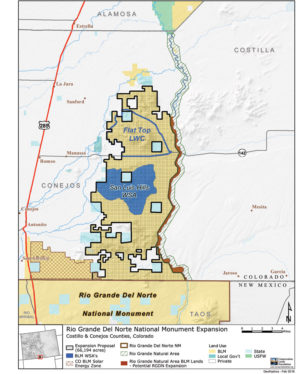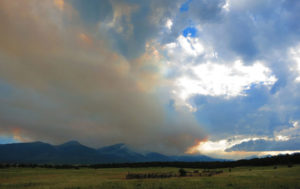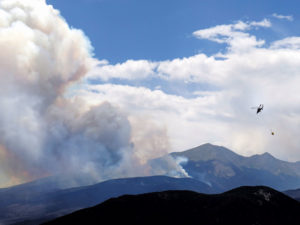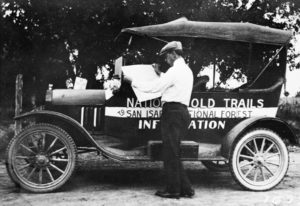By John Mattingly
Wildfires are not inspired by ISIS, but the war on fire and the war on terror share a few futilities. Fighting fire is somewhat like squaring off against the sun.
Sun, water and earth combine to form carbohydrates and sometimes nitrogenized carbohydrates (proteins), all of which burn through either combustion or metabolism in relatively short time spans. Simple carbohydrates, like leaves and vegetable matter, burn relatively quickly and usually within a year. More complex carbohydrates, lignins, like trees, have a longer calendar for burning, but a visit to any forest shows that at all times some of the lignin is being burned, if not by fire then by microbes and bigger creatures. If the full family of carbohydrates did not burn, the litter would make it very difficult to move about on the land surfaces of Earth, and lightning ignitions would be enormously hazardous to mammals. As it is, humans are working industriously on a positive feedback loop of carbon emissions that increase heat and carbon dioxide, that in turn increase heat and carbon dioxide and more forest fires.
There is a significant difference between planetary wildfire processes, and an urban fire set off by faulty wiring or reckless barbecue. That difference can be blurry when, say, an out-of-state camper or love-wounded Forest Service executive sets a fire in the wild, but generally speaking, incorporated municipalities raise taxes to pay for a firefighting force to abate fires within their municipal boundaries caused by human miscalculation. Counties also raise taxes to fund a firefighting force, and many people serve on volunteer firefighting units.
Wildfires are different. Typically and frequently on federal lands, federal agencies are mostly responsible for, and tasked with, managing and fighting fires that originate in or spread to federal lands. While it is true that citizens who pay federal income taxes and have an in-holding or private property adjacent to federal lands are paying for collateral protection, the linkage is a bit fuzzy because a lot of property owners who are unlikely to need protection from a wildfire are paying for those who will. Not that any of us want our fellow citizens’ property scorched by a federal wildfire because we could not scratch up a few bucks for taxes. It is simply true that there is a huge difference between a local firefighting force and a federal response bureaucracy.
To wit, federal authorizing legislation created the National Interagency Fire Center (NIFC), which put forth five “preparedness” levels for any given fire, a designation determined by various factors that require a great number of incident management personnel, analysts, computer models, coordination teams, and finally, grunts on the ground with air support when warranted. It is well worth a visit to the NIFC website for information about fires and detailed descriptions of the five levels of response. A lot of the information presented by NIFC is useful, but some of it is less so, which brings up a point seldom made in our (often) unqualified adoration of firefighting.
As a national agency, NIFC has to be prepared for a host of national particulars, meaning the agency is, of necessity, inefficient. Its mission not only encourages inefficiency and redundancy, but requires it. We need look no further than Dick Cheney’s “one percent threshold” demanding preparedness against terrorism at 99 percent at all levels of enforcement and military that mushroomed into a terror fighting reptile which obliterates efficiency (and sometimes freedom) for a perception of effectiveness. The same can be said of fire-fighting efforts that have occurred in Central Colorado recently.
[InContentAdTwo]
We had a home in downtown Creede when the big fire struck the Rio Grande headwaters. The resources expended to pay competitive wages to hundreds of people who did no more than watch the fire burn, together with the cost of hiring helicopters to dip water from the Rio Grande to dowse 12,000 square-foot vacation homes, added to the manifold redundancies in mobilization, turned the Creede fire into a multi-million dollar jobs program that protected a very small population of wealthy homeowners who were either unwilling or too stupid to mitigate their own property against fire. They now have a trophy home nestled in a forest of charred stumps and smoking scarecrows of dead timber. Most of the Creede wildfire carbonized fuel that was ready to burn and needed to burn and might have burned sooner and less ferociously if previous fires had been allowed to burn their full course. But as we say about the Forest Service – the difference between God and the Forest Service is that God does not think she is the Forest Service.
In some ways, the Creede fire could be characterized by this: one night during the fire I saw that the local convenience store was open at 11 p.m., long past the six p.m. closing time. I went in. The clerk told me, with immense pride and the face of duty, that the store was staying open because firefighters were coming in for supplies. All over town were signs reading, “God Bless Firefighters,” or “Thank You Firefighters,” or “Firefighters Get 50 Percent Off!” The firefighters arrived at the store momentarily in a late-model, jacked-up, one-ton, dual-wheeled truck with hoses and tanks and tricked-out with lights and winches and the works. The heroic firefighters needed twelve cartons of cigarettes. Nothing else. No meat or bread or milk, as these are all supplied to them on site. As they paid the clerk, receiving their fifty percent discount, one firefighter smiled as he air-flicked a butt and said that cigs were his favorite thing because they kept him employed.
Butts aside, global warming, climate change, or climate chaos – whatever you want to call it – is creating a lot of jobs in a firefighting economy that, like the military economy, is engaged in a mission that demands redundancy, a quality that promises job security and guarantees abuses. The Hayden Pass fire raged on terrain that made fighting it on the ground almost impossible. But readiness was there at Level Two. We demanded it, didn’t we? Or did we? Did we order a force of 646 firefighters to be on hand, along with others, hanging around “in case,” or hoping for a chance to move up the bureaucratic ladder to a management position where they can parse levels of preparedness from an office or hotel room rather than get into the smoke and weeds?
Seeing a firefight up close is unlike hearing about a big blaze in Arizona. Up close, fighting fire is an uncertain, unwieldy, and often unfortunate activity that has a certain and wildly promising future.
John Mattingly cultivates prose, among other things, and was most recently seen near Poncha Springs.




